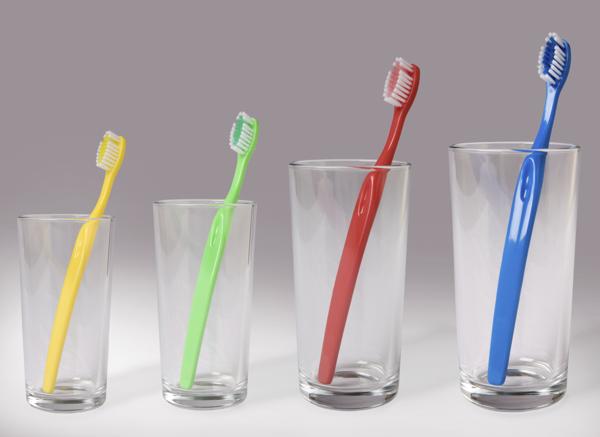
Sharing food, utensils, and toothbrushes, are some ways in which cavitiy-causing bacteria can be transmitted from one person to another.
The culprit – Streptococcus mutans
A dental decay causing bacterium that is contagious and can spread from adults to children, like cold and flu.
As kids, (and even as adults!) we have always dreaded a visit to the dentist. The mere thought of the sharp, shooting pain experienced while filling a cavity was enough to give us cold feet. Speaking of cavities, chocolates and sweets were considered to be the main culprits.
While examining our teeth, the doctor kept reiterating the need to avoid candies, sweets, and chocolates. Our super-protective parents just picked up that line and added to our misery by telling us, “See, I told you not to eat sweets and chocolates”. “You know doc, she never listens!”
But it is not only the sweet stuff (the poor sweets!) that is always responsible for dental cavities. The real culprits are bacteria. Two of them―Streptococcus mutans and Streptococcus sobrinus, who survive on food particles. They remain on the teeth in the form of a thin film-like substance called plaque, and start producing acids. These acids, sooner or later, eat away into the tooth, resulting into a cavity.
But new researches say that you ‘catch a cavity’ from a person who has cavities, which means that ‘cavities are contagious’. Let us take a look at the ways in which cavities become contagious.
From Mama to Baby!
This route is one of the easiest for the bacteria to jump ship from the mother to the child. It is very common for mothers to taste the baby’s food just to make sure it is not too hot. They even blow a little air on the food. This practice should be strictly avoided, and more so, if the mother has cavities.
When the mother tastes the food, before feeding the child, a little saliva is transferred to the spoon. Now, this saliva has S. mutans and S. sobrinus. When she feeds the baby with the same spoon, the bacteria get transferred and find a new place to dwell. As the baby’s mouth is difficult to clean, it becomes a perfect setting for decay, even before the milk teeth begin to appear.
It is seen that a child between the age of 6 to 36 months, is most vulnerable to tooth decay and cavities. So, if you have a kid who falls in that age bracket, be extra careful.
You should not blow air on your child’s food or taste it before feeding. If you have to taste the food anyway, take a little on your palm and taste. Remember! You should stringently avoid your saliva coming in contact with that of your kid.
Contagious Kisses!
I’m not being biased by saying that females have better oral health than men. Out of personal experience, I could say that a female really takes care of her dental health by visiting a dentist more frequently, brushing and flossing regularly, and avoiding too much sweets. (Some) Men are also very particular about their oral hygiene. Although it is not generic, but most men usually believe that, as long as it doesn’t hurt, everything must be fine.
Normally, when a person with good dental health/oral hygiene gets into a relationship with someone who has cavities, the one without the cavities, starts developing them. Usually, kissing is the sinner! (At least when used in context with cavities) Kissing is the way in which the bacteria just keeps going back and forth between the couple.
Feeling a little weird? Don’t worry! It wasn’t to make you swear off kissing, but to make you realize that if you are the one who has cavities, and your partner doesn’t, then spare him/her the dentist’s visit. Practice better oral health. And at present, if you don’t have cavities, and are reading this, then persuade your partner to visit the dentist more often.
Sharing is Bad for Your Teeth!
There is one more way of cavity transfer, there is one more way in which the bacteria-causing cavities can be transferred. It is said that children are more susceptible to developing cavities.
One way is sharing utensils or eating in the same plate. We live in an environment which is not sterile, and even the most diligent individual can sometimes become the one who is preyed upon by the notorious bacteria.
Everyone in the house should have their own toothbrushes, and they should be replaced before the bristles get frayed. No sharing of toothbrushes. Period. By practicing this, you will not only be the one who stops cavities from spreading, but will also set an example of good dental care.
Tips for Preventing Cavities From Becoming Contagious
Visit the dentist every 6 months. Signs such as tooth sensitivity, pain, or visible holes should not be ignored. Regular cleaning should be undertaken.
Using a mouth-rinse with chlorhexidine can prevent the early-stage decay from turning into a cavity. But do not self-diagnose! You may not be able to judge correctly, if the cavity is early-stage or a fully developed one until you visit your doctor.
Chewing a gum which has xylitol as the sweetener can help prevent a cavity. It increases saliva production, and wards off infectious bacteria.
Do not overeat sugary stuff and aerated drinks. With kids, go slow with the chocolate milk. Any confectionery that is really sticky and rich in carbohydrates is the offender.
In summation, I can say that, next time you hear someone saying, “cavities are hereditary”, or “cavities run in our family”, or “I have soft-teeth”, you can tell them that while the anatomy of the teeth can be inherited, cavities cannot. Cavities are contagious and can be passed from one person to the other.





